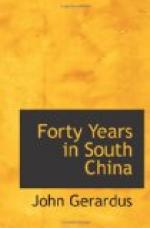It is suggested as an objection to the plan that has been adopted by the missionaries at Amoy, that “where two Presbyteries have jurisdiction over one man, it may not be always easy to define the line where the jurisdiction of the one ends and the other begins; and for the foreign Presbyter to have a control over the native Presbyter which the native cannot reciprocate, would be anomalous, and contrary to that view of the parity of Presbyters which the Scriptures present.”
From our last paragraph above it will be seen that the “line” of demarcation alluded to in the first half of the above objection has certainly never yet been defined by Tai-hoey, but it will be seen likewise that we have no apprehension of any practical difficulty in the matter. The last half of the objection looks more serious, for if our plan really involves a violation of the doctrine of the parity of the ministry, this is a very serious objection—fatal, indeed, unless perhaps the temporary character of the arrangement might give some sufferance to it in a developing church. It does not, however in our opinion, involve any such doctrine. It does not touch that doctrine at all.
The reason why Tai-hoey does not claim the right of discipline over the missionaries is not because these are of a higher order than the other members, but because the missionaries have a most important relation to the home churches which the other members have not. The Tai-hoey respects the rights of those churches which have sent and are still sending the Gospel here, and has fullest confidence that they will exercise proper discipline over their missionaries. Whether they do this or not, the power of the Tai-hoey to cut off from its membership, or refuse to admit thereto, any missionary who might prove himself unworthy, gives ample security to that body and secures likewise the benefits of discipline. If time allowed us to give a full description of our Church work here it would be seen that the doctrine of the parity of all who hold the ministerial office so thoroughly permeates the whole, that it would seem impossible for mistake to arise on that point.
In connection with this subject it is also remarked “that where two races are combined in a Presbytery, there is a tendency to divide on questions according to the line of race.”
With gratitude to God we are able to bear testimony that at Amoy we have not as yet seen the first sign of such tendency. We have heard of such tendency in some other mission fields. Possibly it may yet be manifested here. This, however, does not now seem probable. The native members of Tai-hoey, almost from the first, have outnumbered the foreign. The disproportion now is as three or four to one, and must continue to increase. It would seem, therefore, that there will now be no occasion for jealousy of the missionaries’ influence to grow up on the part of the native members.




